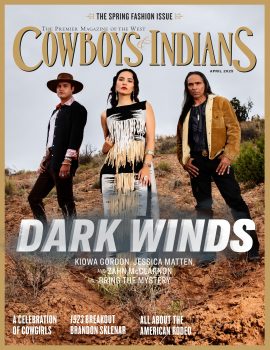A new exhibition at a new(ish) lifestyle gallery in Santa Fe visually extols man’s best environmental friend and has one of man’s best furry friends on hand, too.
The Museum of Trees, a solo exhibition of the work of Carol Tippit Woolworth, debuts at Smilow Mathiesen A Lifestyle Gallery on December 7 with a VIP tour and remains on view for a month.
This being Santa Fe and this being a lifestyle gallery, you’ll not only see distinctive paintings you’ll want to take home: You’ll meet gallery owner Karen Park’s big sweet black dog Bubbles, who comes to the gallery every day.
Smilow Mathiesen is housed in a historic turn-of-the-century building on the iconic Canyon Road. Flowing from one room to another, the space draws you in, and the art and the atmosphere keep you there in casual thrall. Through December, Tippit Woolworth’s evocative layered paintings heighten the atmosphere.
A classically trained painter working in oil, cold wax, and gouache, Tippit Woolworth has exhibited in Santa Fe since 2016 and has shown extensively throughout the United States. Widely collected and held in private collections worldwide, her paintings portray textured landscapes, figures, and animals adeptly rendered in light and shadow.
The Museum of Trees paintings are both beautiful and chilling, imagining as they do a world in which dislocated humans walk among fake trees, having taken the beauty and importance of real trees — and perhaps each other — for granted.
C&I talked with the artist and the gallerist about making and exhibiting art, the new show, the creative life, and settling in Santa Fe.
A Conversation With Painter Carol Tippit Woolworth
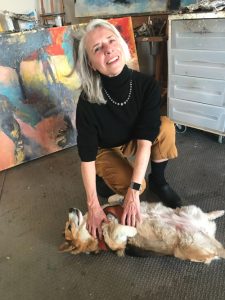 Cowboys & Indians: Your website describes your work as “oil and gouache paintings working towards the abstract figurative.” What do you mean by that?
Cowboys & Indians: Your website describes your work as “oil and gouache paintings working towards the abstract figurative.” What do you mean by that?
Carol Tippit Woolworth: It seems my journey is to set myself free. As a young painter I didn’t have the confidence to trust my inner voices, so my worked tended to very realistic. I wanted an apple to look like an apple, an orange to look like an orange. I wanted them sitting on a table, or in a dish, and I wanted my work to look just like that particular set up. Over the years, as confidence has been gained, my work has become more expressive, and thus more abstract. It is still defined by realism, but now I contort those figurative objects into color and shapes and contrasts of lights and darks. Once I was exposed to the Bay Area Figurative Abstract Painters my life changed. These artists forced me out of my comfort zone and into areas of pure expression. So. I'm still a figurative painter, searching for the key to unleashing the energy in each piece I paint. Which is abstract.
C&I: Born in California, you spent a long time on the East Coast before relocating to Santa Fe. Why Santa Fe?
Tippit Woolworth: Santa Fe has always been in my blood. As a child, we would drive Route 66 every summer to visit my parents’ families in Oklahoma, passing through Albuquerque and Santa Fe. There was so much mystery seeing the Navajo people walking along the road in velvets and jewelry, the dramatic landscapes which pulled me in even as a child, the food. Later, my favorite art teacher talked about the beauty of Santa Fe and the artist scene.
At one point, in the early ’80s before I’d moved east, I came here to check it out, but it was in November and brown and bleak and coming from Santa Barbara ... well ... just didn't seem the time. Then a few years back we visited some friends here who showed us their Santa Fe, and we were hooked. It turns out my husband’s family has deep roots in Santa Fe. His grandmother was a TB patient at Sunmount Sanitarium in the 1910s, his father was born at what is now the Drury Hotel, and his parents met and married here. Guess it was inevitable.
C&I: What inspires you as a painter?
Tippit Woolworth: Everything inspires me as a painter! Mainly seeing and finding beauty in the mundane — the everyday things we go by and not notice. I feel like part of my job is to illuminate those bits all around us, and force people to witness their world as something astonishing. And fragile.
Click on the image below to see a slideshow.
C&I: What have California, the East Coast, and Santa Fe each given you as an artist?
Tippit Woolworth: Good question. In California I was the student. That’s where I went to school, learning the fundamentals of color and composition and about the lives of other artists. After school I had to unlearn everything. I had to scrap the safe, academic hole I’d placed myself [in] and open up to the dangerous parts.
Manhattan taught me that the fantasies of an artist’s life were just that — fantasies. Art was actually a business, not some kind of rosy idea of an artist locking themselves up in a turret to create pieces the world would clamor to buy. The art world was cutthroat! At least there. So I took classes and painted for myself and went to museums and galleries.
When I moved to Delaware the gates opened. It was a small world with lots of artists and art appreciators and I was able to navigate this world wonderfully. Here’s where I gained confidence and forced myself to paint every day, which enabled me to understand the nuances of painting which I hadn’t figured out before. It’s also where I started teaching, in the local arts college, and privately.
Santa Fe? Well. It seems the pinnacle. All that learning and striving from the West Coast to the East. Here? It’s all come together. My paintings are mature, my confidence strong. It’s home.
C&I: You also teach. What is one of the main lessons of painting/being a painter that you really want your students to internalize and incorporate?
Tippit Woolworth: As a teacher the most important lesson for a student to learn is how to see. My goal is to strip a student’s ingrained concept of an “icon” one sees in one’s mind of, say, an apple or pear or tree, and force them to actually see the object. To feel it. To ramble over the surfaces and understand how light and dark create the object. So many of my students come to me, and I have them draw from a pear sitting on a table, and I watch them draw it, never once looking up at the object, but rather depending on the concept of “pear” they hold in their minds. My job is to make them see the actual object. It’s thrilling to see the light pop into their eyes as they understand the difference. Sort of like the Miracle Worker!
C&I: Your new work, The Tree Museum, now on view at Smilow Mathiesen, suggests environmental imperatives without the pedantic politics. What are you hoping people will appreciate in this work visually, and, just as important, metaphorically?
Tippit Woolworth: I came up with this concept back East, when every morning I would walk around the most beautiful river, framed on either side by ancient, massive trees and watch people on the same walk fastened to their phones. Here are all of these folks missing out on this incredibly beautiful area and one of these days it’ll be gone and they’ll have missed it. Instead, they’ll be looking at what once was — trees — on their phones!
Now, with the tragic reality of climate change, and with it this idea of nature disappearing before our eyes, this concept isn’t so far-fetched. Soon we will be looking at nature as we look at animals in a zoo. As a pessimist, it just seemed a way to alert people to a bleak future. Now is the time to act. A side part of this concept is the people roaming the galleries, most of them in their own worlds, unable to interact.
As for a visual statement? I hope people connect with the colors and layering of paint. I’ve also tried to create compositions that straddle the surfaces, tied in by color and contrast, creating a sense of isolation since few objects are actually relating.
C&I: What’s your creative process like? Your studio?
Tippit Woolworth: For this series I did something different as far as my creative process is concerned. I wanted the figures, human and tree, to seem fake, so I created a fake world. I bought some miniature train figures, which were an inch high, and trees to match, then set them up on a Styrofoam board and made close-up photos of the figures with trees. When I looked at the photos I was shocked to see all of the detail in these ’40s figures! Then came the paintings.
I tend to work on several pieces at a time since the work is layered. Each layer needs to set before I can continue on to the next one.
My studio is a mess. I paint in a frenzy. Pieces lean against walls and tables, and paint is splattered on the floor and walls and me. Books of my favorite painters, David Park and Nicolas de Staël, are open near my easel as references when I get stuck.
C&I: What would you like to say about your work that most interviews don’t get at?
Tippit Woolworth: Perhaps it’s that I paint from my gut. Truly. I never actually know how things will turn out, what direction one piece will go as opposed to the last one. I think too, I keep hearing how artists need to be consistent and always paint for the collector, but that isn’t me. So many ideas jam my brain, and each one needs to be explored to the end. And by painting like this I am constantly moving forward, learning new things, deepening the work. That seems so important as an artist — to constantly grow and experiment. Think of Picasso, Matisse.
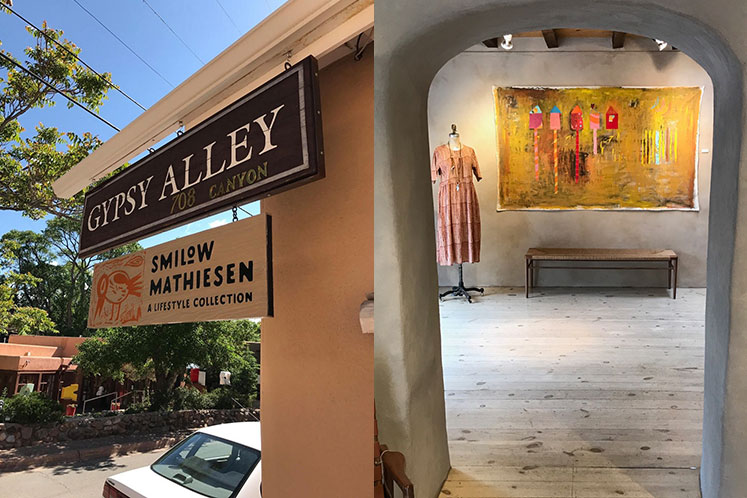
A Conversation With Karen Park, Founder Smilow Mathiesen A Lifestyle Gallery
Cowboys & Indians: What led you to the creative life?
Karen Park: I was probably born with creative genes — born and raised [on a] rural pineapple plantation by a father who was an accomplished classical violinist. I took piano lessons many years and was raised around classical music. My parents were not rich, but in our tiny plantation home we lived with midcentury Heywood Wakefield furniture and only had the best of everything. We drove around on dirt roads in a Studebaker sedan that looked like it was out of The Jetsons! By the time I left for college there was no doubt I would end up doing something creative.
C&I: How did your career evolve so that you now find yourself opening a new(ish) gallery in Santa Fe?
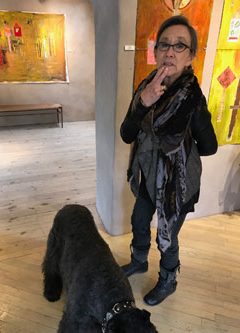 Park: While I raised my family I did volunteer work as a docent in a local museum, where I learned more about fine art. Once my children were in college I relocated from Hawaii to the San Francisco Bay Area, which is where I developed my career in fine retailing. For 20-plus years I worked as a manager at Neiman Marcus, Saks Fifth Avenue, I. Magnin, and Jil Sander, where I experienced retailing at the highest level and forged relationships that would help me throughout my career. I opened my own store in Berkeley, California, in 2004; we developed a reputation for having a unique, well-curated selection of merchandise for women. In 2016 it was time to move on after 13 years in business. Seeking a slower pace and better quality of life, Santa Fe was the natural place to end up.
Park: While I raised my family I did volunteer work as a docent in a local museum, where I learned more about fine art. Once my children were in college I relocated from Hawaii to the San Francisco Bay Area, which is where I developed my career in fine retailing. For 20-plus years I worked as a manager at Neiman Marcus, Saks Fifth Avenue, I. Magnin, and Jil Sander, where I experienced retailing at the highest level and forged relationships that would help me throughout my career. I opened my own store in Berkeley, California, in 2004; we developed a reputation for having a unique, well-curated selection of merchandise for women. In 2016 it was time to move on after 13 years in business. Seeking a slower pace and better quality of life, Santa Fe was the natural place to end up.
C&I: Describe your gallery space and your vision for it.
Park: The gallery is housed in an 1,800-square-foot building on historic Canyon Road. There are multiple rooms which serve as “little galleries,” where art and merchandise can be showcased together, creating a flow from one room to another and creating a visual and sensual experience for the viewer.
C&I: What do you mean by “a lifestyle gallery”?
Park: The gallery was created as a lifestyle gallery representing not only fine art but also jewelry, textile, and clothing as I consider designers in these medium to be artists as well. The lifestyle concept hopefully sets us apart from other galleries. In trying to develop a local clientele, it is more likely locals will remember us as a destination for their guests and to talk about us as being unique and different from the traditional gallery.
C&I: Any standout experiences (funny and gratifying things, challenges) on your artistic journey?
Park: The one thing that sticks in my mind after all my years as a small-business owner is women would come into my store and comment, “I feel like I’m in a museum!”
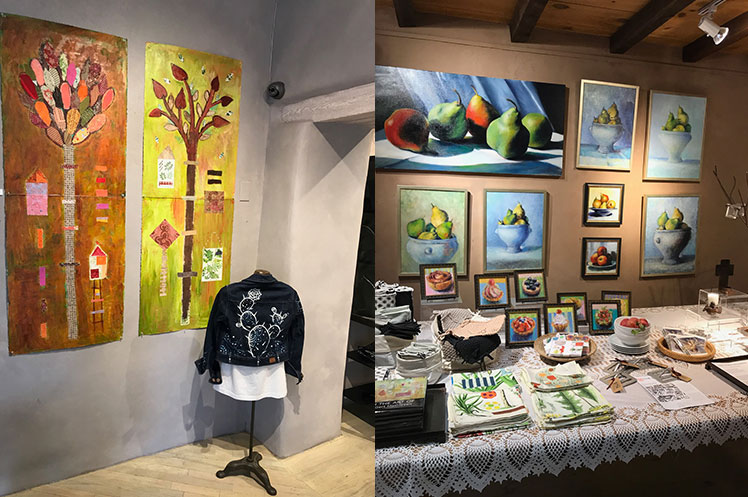
C&I: Why Santa Fe?
Park: I was first introduced to Santa Fe many years ago while attending college. I would spend holidays with my aunt and uncle in Albuquerque. Short visits to Santa Fe always left an indelible memory and I continued to visit whenever I had a chance. There was always a sacred, spiritual calling, so when I made the decision to leave the Bay Area there was no doubt where I would end up.
C&I: How do you suggest people best experience art in Santa Fe?
Park: This is a tough one. Art is everywhere in Santa Fe. One can experience art here just by being aware of the environment. The architecture is like nowhere else. Adobe buildings blending into the landscape, sculptures in public spaces while walking around town, and taking in a museum or two and a gallery or two or more, but also realizing that being in Santa Fe means experiencing the cultures and traditions of this very historic city.
C&I: What do you have coming in 2019?
Park: As time has gone by I have met many artists whose work may be featured as a guest artist. The gallery is named after Pam Smilow and the late Gert Mathiesen, an artist couple from New York who have been longtime friends. Their work is a constant in the gallery and will continue to revolve with guest artists’. I hope to continue building awareness in this area of the work of Natalie Chanin’s textile collection, Alabama Chanin.
For additional information about artist Carol Tippit Woolworth, visit caroltippitwoolworth.com. For more on Smilow Mathiesen A Lifestyle Gallery, visit smilowmathiesen.com.
Photography: Slideshow images © Carol Tippit Woolworth, Gallery Images Courtesy Smilow Mathiesen A Lifestyle Gallery

























